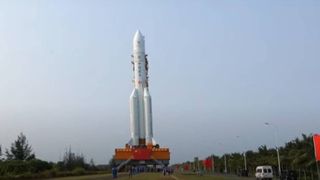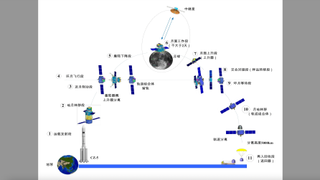
China to launch sample-return mission to the moon's far side on May 3
The Chang'e 6 mission is reportedly scheduled to launch early Friday morning (May 3).

Launch preparations are quickening for China's next spacecraft sendoff to the moon — the robotic Chang'e 6 mission.
The spacecraft now sits atop a Long March 5 rocket at its departure site in Wenchang, in China's Hainan province. Chang'e 6 is reportedly scheduled to launch on Friday (May 3) at 3:50 a.m. EDT (0759 GMT; 3:50 p.m. Beijing time).
The 8.2-metric-ton Chang'e 6 is targeted to touch down in the South Pole-Aitken (SPA) Basin on the far side of the moon. The mission consists of four components: an orbiter, a lander, an ascender and a reentry module.
Related: The latest news about China's space program
First-time try
Chang'e 6 will make the first-ever attempt to return dust and rocks from the lunar far side. If all goes to plan, these samples will be placed on the ascender for transport from the surface into lunar orbit, followed by transfer into a reentry module that hauls the collectibles to Earth.
The United States, the former Soviet Union and China have all brought lunar samples to Earth. China was the most recent to do so, with its Chang'e 5 mission in 2020. But all of this material was collected on the near side, the part of the moon that's always facing Earth.
China scored the first-ever soft landing on the lunar far side with its Chang'e 4 lander-rover mission back in early January 2019.
Get the Space.com Newsletter
Breaking space news, the latest updates on rocket launches, skywatching events and more!
According to Xingguo Zeng, of the Laboratory of Lunar and Deep Space Exploration at the National Astronomical Observatories, Chang'e 6 is designed to address questions about the multiple lunar near side–far side dichotomies, and to provide new insights into both the early impact history of the solar system and the geological evolution of the moon.
Toward that end, Chang'e 6 will touch down in the southern part of the Apollo basin, which provides access to a diversity of SPA material, Xingguo recently stated in a paper published in Nature.
Related: The moon: Everything you need to know about Earth's companion
Design and control
"The Chang’e 6 aims to achieve breakthroughs in the design and control technology of the moon's retrograde orbit, intelligent sampling, takeoff and ascent technologies, and automatic sample-return on the far side of the moon," Ge Ping, deputy director of the Center of Lunar Exploration and Space Engineering for the China National Space Administration, told told China Central Television (CCTV).
“At present, the Long March 5 carrier rocket and the Chang'e 6 probe are in good condition," Ge added. "All preparations for the launch are progressing in an orderly manner, following normal working procedures."
Liao Guorui, an engineer at the Wenchang Spacecraft Launch Site, told CCTV:
"At present, the launch site has ensured the normal testing of Chang'e 6 and the Long March-5 Y8 carrier rocket. Our Hainan launch site features high temperatures, high humidity, and high salt mist. We have made corresponding preparations for the environmental conditions, and we have also prepared some typhoon prevention plans to adapt to the weather in Hainan."
Details of the launch window were spotlighted by Zhu Haiyang, a staff member with the China Academy of Launch Vehicle Technology.
"The signature feature of the Chang-e 6 mission is that it has extra high requirements for the launch window, mainly due to the lunar orbit. In order to achieve an optimal energy, it has a high requirement for the launch time of the rocket and the time of delivery to the Lunar Transfer Orbit [LTO], so the launch window is relatively narrow," Zhu told CCTV. "We have carried out some verifications for the 'narrow window and multi-orbit' technology."

Transfer point
For this Chang'e 6 launch, 10 lunar orbits for the rocket have been designed. Chang'e 6 needs to enter the LTO with a perigee (closest approach point) of 125 miles (200 kilometers) and an apogee (most distant point) of 255,000 miles (410,000 km), and the requirement for orbit entry accuracy is also extremely high.
"As for the rocket, we mainly need to send it to the LTO transfer point,” Zhu added. "In terms of process coordination before launching at the launch site, coordination and drills were also carried out around the narrow window multi-orbit technology. With higher accuracy in orbit insertion, less propellant will be consumed by Chang'e-6 for its attitude adjustment, including orientation, orbit elevation, and orbit change."
Scoop and drill
According to James Head, noted lunar scientist at Brown University, the Chang'e 6 mission is very similar to Chang'e 5 in terms of its spacecraft and its operational strategy: It will acquire scoop and drill samples, totaling perhaps up to 4.4 pounds (2 kilograms).
The recently launched Queqiao 2 far side communications satellite is in lunar orbit, tested, and is fully functional to support not only the Chang'e 6 mission but also the follow-on Chang'e 7 and Chang'e 8 robotic expeditions, which will support the establishment of a moon base called the International Lunar Research Station (ILRS), Head said.
Join our Space Forums to keep talking space on the latest missions, night sky and more! And if you have a news tip, correction or comment, let us know at: community@space.com.

Leonard David is an award-winning space journalist who has been reporting on space activities for more than 50 years. Currently writing as Space.com's Space Insider Columnist among his other projects, Leonard has authored numerous books on space exploration, Mars missions and more, with his latest being "Moon Rush: The New Space Race" published in 2019 by National Geographic. He also wrote "Mars: Our Future on the Red Planet" released in 2016 by National Geographic. Leonard has served as a correspondent for SpaceNews, Scientific American and Aerospace America for the AIAA. He has received many awards, including the first Ordway Award for Sustained Excellence in Spaceflight History in 2015 at the AAS Wernher von Braun Memorial Symposium. You can find out Leonard's latest project at his website and on Twitter.
